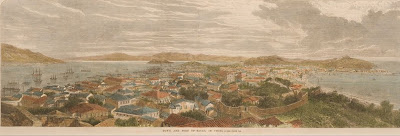"Town and port of Macao" é a legenda desta ilustração publicada no The Illustrated London News a 27 de Novembro de 1869.
O artigo:
"The Portuguese colony of Macao at the mouth of the Canton river was founded in 1557 and was formerly the chief emporium of trade of European nations with China. Its importance has very much declined since the establishment in 1842 of the British commercial settlement on the opposite island of Hong Kong.
The town is curiously situated on a small hilly peninsula two or three miles long connected by a low sandy isthmus not half a mile wide with the mainland or rather with the large island of Hiang Shan which separates two channels of the estuary from each other.
There are three hills from 200 ft to 300 ft high upon the sides of which and upon a flat irregular table land between them the streets of the town are built.
The Praya Grande is a fine marine esplanade with a granite sea wall and a broad roadway extending half a mile in a bold curve along which from the Public Gardens at the east end to the foot of the Penha hill at the west are terraces of plain but substantial houses. In the centre is Government House a building of more architectural pretension.
The older part of the town on the summit of ridge consists of winding narrow streets with an open Plaza in which the cathedral stands and with several handsome old churches. The chief resort of shipping is the Inner Harbour on the other side of the peninsula. The Portuguese poet Camoens resided some time at Macao."
Tradução:
A colónia portuguesa de Macau, na foz do rio Cantão, foi fundada em 1557 e foi anteriormente o principal empório de comércio das nações europeias com a China. A sua importância diminuiu muito desde o estabelecimento, em 1842, da colónia britânica de Hong Kong.
A cidade está curiosamente situada numa pequena península montanhosa com duas ou três milhas de comprimento, ligada por um istmo arenoso baixo, com menos de meia milha de largura, ao continente, ou melhor, à grande ilha de Hiang Shan, que separa dois canais do estuário um do outro.
Existem três colinas de 200 a 300 pés de altura, nas laterais das quais e sobre um tabuleiro plano e irregular entre elas, estão construídas as ruas da cidade.
A Praia Grande é uma bela esplanada marítima com um paredão de granito e uma larga estrada que se estende por oitocentos metros numa curva arrojada ao longo da qual desde o Jardim Público (S. Francisco), no extremo nascente, até ao sopé da colina da Penha, no poente, existem terraços planos e grandes casas. No centro fica a Casa do Governo, um edifício de maior pretensão arquitectónica.
A parte mais antiga da cidade, no cume da colina, consiste em ruas estreitas e sinuosas com uma praça aberta onde fica a catedral e com várias belas igrejas antigas. O principal meio da navegação é o Porto Interior, do outro lado da península. O poeta português Camões residiu algum tempo em Macau.

Sem comentários:
Enviar um comentário